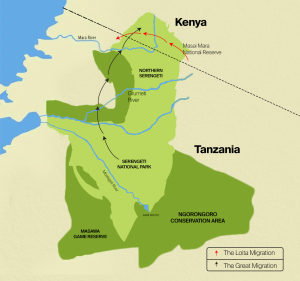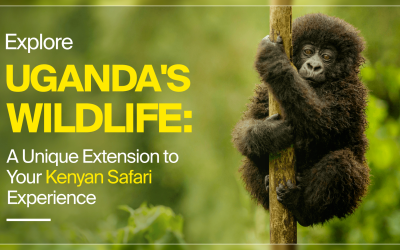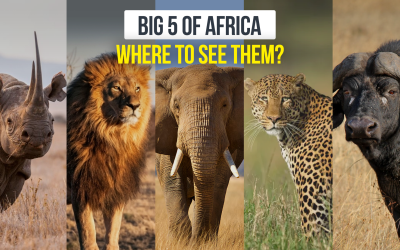Kenya’s Best Kept Secret: the Loita Migration
The Great Migration—a spectacle of millions of wildebeest crossing the Mara River—occurs in July and August; another migration—the Loita Migration—quietly unfolds between January and March, captivating those who seek a more intimate connection with nature. While Kenya’s migration safari in July and August is a huge draw, the cognoscenti actually prefer the Loita Migration, a hidden gem offering unparalleled tranquility and a front-row seat to nature’s quieter yet mesmerising spectacle.
This lesser-known movement of wildebeest occurs in the serene Loita Plains and the conservancies of Ol Kinyei, Naboisho, and Olare Motorogi, just northeast of the famous Masai Mara National Reserve.
Let’s explore what makes the Loita Migration an unparalleled experience for wildlife enthusiasts, photographers, and adventurers.
What is the Loita Migration?

Unlike the Great Migration, which sees wildebeest moving between the Serengeti and Masai Mara, the Loita Migration is a more localised phenomenon. Each year, tens of thousands of wildebeest and zebras migrate east to west from the Loita Plains to the Mara ecosystem in search of fresh grazing lands and water. The migration usually begins in December when the short rains create a lush feeding ground. By March, herds gradually make their way into Mara conservancies. June to October is another duration when you can see herds returning to the Loita plains.
A Glimpse of the Action
Picture this: it’s early morning, and the sun is just beginning to rise over the Loita Plains. The soft golden light paints the grasslands in warm hues, and the air is alive with the distant calls of wildebeest. You’re on a game drive, watching in awe as thousands of these animals move in long, winding lines across the plains. Their movements are calm, almost rhythmic, as if they’ve done this journey for centuries.
Suddenly, your guide points to a lioness perched high in a tree, her eyes fixed on the herd below. It’s a rare and unexpected sight. Lions don’t usually climb trees, but here she is, using her elevated position to scout for her next meal. The tension is palpable as you wait to see what will happen next.
The next morning, you return to the same spot. The lioness is gone, and so is the wildebeest. But not far from the tree, you spot the remains of a wildebeest—evidence of a successful hunt. It’s a powerful reminder of the cycle of life that plays out daily in these wild lands. These moments—raw, unfiltered, and deeply connected to nature—make the Loita Migration special.
Why Choose the Loita Migration?
1. The Best Private Safari Experience
One of the most important reasons for witnessing the Loita Migration is its originality. Unlike the busy Masai Mara during the peak migration season, the Loita Migration lets you enjoy the beauty of the wildlife during a Kenya wildlife safari without the tourist vehicles vying for the perfect shot. The beauty of visiting during the Loita Migration is often having the vast plains all to yourself, creating a safari experience that feels profoundly personal.
2. Incredible Predator Activity
Where there are wildebeest, predators are never far behind. The Loita Migration attracts lions, cheetahs, hyenas, and jackals, all of which benefit from herds as they traverse their territories.
During this time, predator activities increase with frequent hunts and dramatic chases occurring across the plains. Witnessing a lioness settle on a tree, scouting for her next hunt, or a cheetah sprinting in pursuit of prey is an adrenaline-pumping experience unique to this migration.
3. Unparalleled Birdwatching
The Loita Plains and the conservancies it spans are a haven for bird enthusiasts. From lilac-breasted rollers to secretary birds and various raptors, the skies here are as dynamic as the plains below. During the migration, the presence of wildebeest increases the insect population, attracting bird flocks that create spectacular aerial displays.
When to Visit the Loita Migration
Whether it’s dry season or wet season, the action never settles in a Kenya safari, making it a year-round destination to go on a safari. However, if you’re particularly interested in witnessing the Loita Migration, plan your safari between January and March. This is the calving season, when the plains come alive with new life, creating an excellent opportunity for tourists to spot predators.
By April, the herds begin moving towards the Mara Conservancies. June to October is another great time to visit, as the herds return to the Loita Plains.
Tips for an Unforgettable Loita Migration Safari
- Book Safari with Experts: Safari experts—The Bucket List Travel Co.—can make all the difference, enhancing your safari with fascinating insights and ensuring you don’t miss any key moments.
- Stay in a Conservancy Camp: For an immersive experience, opt for accommodations within community conservancies.
- Pack for All Weather: The weather can be unpredictable, so bring layers for chilly mornings and light clothing for warmer afternoons.
- Bring a Good Camera: The Loita Plains’ stunning landscapes and abundant wildlife deserve more than a smartphone’s lens. An ideal camera is a DSLR or mirrorless camera with a zoom lens.
Discover Africa’s Hidden Gem with The Bucket List Travel Co.
At The Bucket List Travel Co., we specialise in creating tailor-made safari experiences that go beyond the ordinary. We guide you to Kenya’s best-kept secret and help you create memories that will last a lifetime.
Contact us to book your Loita Migration safari today.



